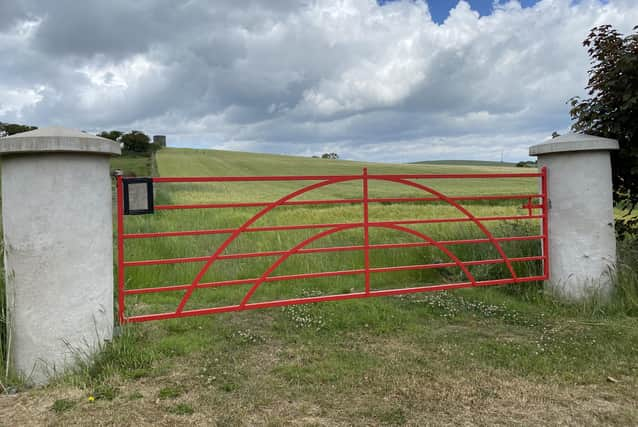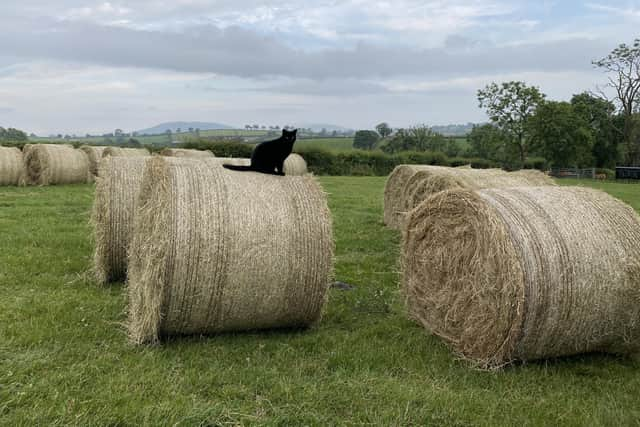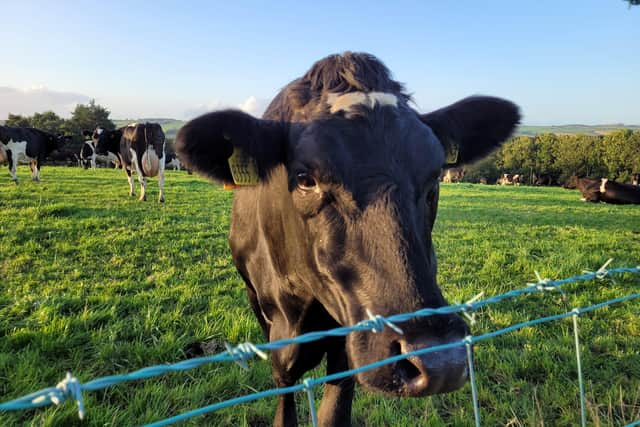It’s been a majestic year forfarming in Northern Ireland


Personally, I agree with farm minister Edwin Poots when he says that farming for carbon should be developed as another income stream for production agriculture and our rural areas. And we must never forget the significance of food security moving forward.
Protecting the environment and feeding people are two sides of the same coin.
Advertisement
Advertisement
I would be pretty confident that most farmers in Northern Ireland will look back on 2021 with a fair degree of satisfaction. The weather played its part and all of the main food commodity markets gathered strength as the year progressed.


In fact farming, entered this year in a pretty robust condition. The previous year had seen vast swathes of the general public re-acquaint themselves with home produced food, as a consequence of the Covid-19 lockdown. And this welcome momentum was carried through into 2021.
But how did matters actually progress down on the farm over the past 12 months? Ask any farmer to make a New Year wish and, invariably, he or she will be asking for a decent year’s weather ahead. And this is undoubtedly so, where arable is concerned.
Throughout my lifetime I have been around on so many occasions when growers had developed huge potential in their crops throughout the spring and early only to have their hopes dashed entirely by atrocious harvest weather.
Advertisement
Advertisement
Thankfully, 2021 was one of those years when arable farming became, for the most part, a care-free experience. All cereal crops – winter and spring – established well. Follow up field work was carried out in timely fashion. And, of course, the sun kept on shining throughout the harvest period.


The end result of all this was the generation of near record yields, for both grain and straw. And, of course, the real icing on the cake was the strengthening of global cereal markets throughout the entire 2021 growing season.
I haven’t heard the final cereal yield figure for Northern Ireland. South of the border the final figure came in at 2.3m tonnes with winter barley and oat crops performing extremely well.
It’s not often that cereal growers can avail of both very high yields and excellent prices at the same time. But such was the case in 2021. And the news just kept on improving given the excellent planting conditions that were enjoyed by those cereal producers committing to winter barley, oats and wheat for 2021/2022.
Advertisement
Advertisement
Arable has a lot to offer farming as a whole in Northern Ireland. This idea that there is not a significant acreage of good tillage ground available to the industry is a bit of a myth.
Back in the 19th century farmers here grew large areas of oats. Horses then were the power house of the farming industry: they had to be fed.
I have a vague recollection from student days that oats can be the most challenging of all cereal crops to grow. So if we could achieve such high levels of grain output 100 plus years ago: why not now?
It’s important that the Stormont Executive continues to support the arable sector. The trial protein scheme, soon to enter its second year, is an excellent example of what can be done in this regard.
Advertisement
Advertisement
The uptake of the measure was acceptable this year. Let’s hope it gains further momentum in 2022. Crops like field beans and peas have everything going for them. They are a much needed spring planted option for cereal growers. Moreover, they need very little fertiliser nitrogen to secure optimal yields: both peas and beans are legumes.
And of course the market for home grown protein is, potentially, enormous.
Potato growers also had a good year in 2021. The tipping point for spuds is always the harvest. It is my understanding that the vast bulk of this year’s main crop is now in store and tuber quality is excellent. Let just hope that potato prices remain strong from now through to the spring and early summer of next year.
Grass is, and will always remain, the main crop grown in Northern Ireland. Our land and climate are perfectly suited to the growing of this unique forage.
Advertisement
Advertisement
While every other country around the world plays at producing pasture – including New Zealand – we here can produce meaningful tonnages of beef, milk and lamb from grass. This is our ‘ace in the pack’ and we must never let it be taken away from us.
Apart from the dry spell that hit in July, 2021 will go down as a very satisfactory grass growing year. This was particularly so at the back end. The rains that fell in August – after the intense heat of July – boosted sward growth rates well into the autumn.
What’s more, ground conditions held up well into October and early November. In turn this allowed beef and dairy producers to keep animals out well beyond their normal housing dates.
A shorter winter (let’s hope) serves to reduce livestock farms’ reliance on expensive concentrates feeds while also taking the pressure off slurry stores.
Advertisement
Advertisement
While the 2021 grazing season ticked almost all of the boxes available to it, the same cannot be said where silage is concerned.
I am hearing that mycotoxin contamination is a real issue within many silage clamps across Northern Ireland at the present time. Farmers can address the problem by including binders in the feed they offer their stock. But what is causing the problem in the first place?
Laboratory testing has also confirmed a very definite north: south split, where the mycotoxin issue is concerned. I know that large numbers of dairy farmers here in Northern Ireland are now committing to multiple cut silage systems in order to maximise the quality of the silage they offer stock throughout the year.
So, could bringing heavy machinery into fields four and maybe five times in a year have some sort of bearing on this ‘growing’ mycotoxin issue? Certainly, it’s a matter that needs to be investigated.
Advertisement
Advertisement
The problem with mycotoxins is that they cannot be seen with the naked eye. Nor will they show up in a standard silage analysis. But they will impact, big time, on animal performance and health if the organisms that produce them manage to gain a foothold within silage clamps and grain store.
Beef and milk returns continued to gain strength throughout 2021. And there seems to be no downturn in farm gate prices coming as we look towards 2022.
So much for the good news: the downside for beef and dairy producers over the past 12 months has been the continuing focus by environmentalists – and governments – on the methane producing power of ruminant livestock.
Matters came to a head at November’s COP-26 event when world leaders agreed a net 30% reduction in global methane levels by 2030.
Advertisement
Advertisement
So it’s time for a reality check: our farming and food industries have already lost too much ground to the environmental lobby, where climate change is concerned. Our reliance here on grass-based production system should always have been accepted as a given.
Had this been the case, the arguments concerning our reliance on ruminant livestock production would never have had to be made in the first place. And this is a reality that our politicians should be thinking long and hard about over the Christmas and New Year holidays.
So let’s not compound the problem by dragging our beef, dairy and sheep industries into the COP-related methane decision.
The case for a methane exemption to be secured for Northern Ireland’s dairy, beef and sheep sectors is an easy one to make. Countries with large oil, coal, gas and manufacturing sectors can – I’m told – quite easily tweak these industries to meet the guidelines established at COP-26.
Advertisement
Advertisement
This is not the case in Northern Ireland. Production agriculture is our largest ‘manufacturing’ industry. If it is directly exposed to the 30% methane reduction target, the potential impact on cattle numbers is obvious. Such a move would also have a very direct bearing on UK food sufficiency levels.
Lack of labour is now a critically important challenge for agriculture as a whole in Northern Ireland. This issue can be seen playing out most clearly than within the pig sector.
The current year has also seen both our pig and poultry industries impacted by a combination of labour availability and tightening environmental regulations linked to planning and the inability to push forward with so many farm development plans.
Underpinning all of this, in my opinion, is the need to deliver sustainable, long-term farm gate prices.
Advertisement
Advertisement
If these can be achieved, farmers will then be in a position to commit to the future of their businesses in a meaningful way. Climate change alone will require huge investment to be made across every facet of agriculture in order to future proof the industry.
And, of course, farmers must be allowed to generate a sustainable income for themselves and the people they employ.
Meanwhile our politicians continue to ‘play games’, where the future of farming and food is concerned. It’s obvious to the dogs in the street that we only need one climate change bill for Northern Ireland. So it beats the hell out of me as to why Edwin Poots and Clare Bailey cannot sit round a table and sort out their differences.
Politics is supposed to be the art of the possible. And I see no reason why both politicians cannot come up with an agreed legislative format for climate change, which would see neither losing face.
Advertisement
Advertisement
I referenced above the need to deliver sustainable farm gate prices into the future. The last 12 months have seen Farmers for Action continuing to press for the introduction of guaranteed prices’ legislation at Stormont.
The coming weeks will tell if this approach will gain real momentum. However, it is worth noting that the European Commission is at last looking seriously at delivering a form of genuine price stability for farmers across Europe.
And steps like this will be genuinely needed. Recent months have seen all the input costs incurred by farming businesses sky rocket with feed, fuel and fertiliser particularly in the firing line.
The deflating impact of these trends on farm business margins is obvious. And, no doubt, this will continue to be the case as we enter the early months of 2022.
Advertisement
Advertisement
But let’s not get too depressed. The year just ending has brought out the very best across farming in Northern Ireland. The weather played its part in allowing producers get on with the jobs they just love doing.
The problem is that we can only hope – not expect – a repeat of the same in 2022.